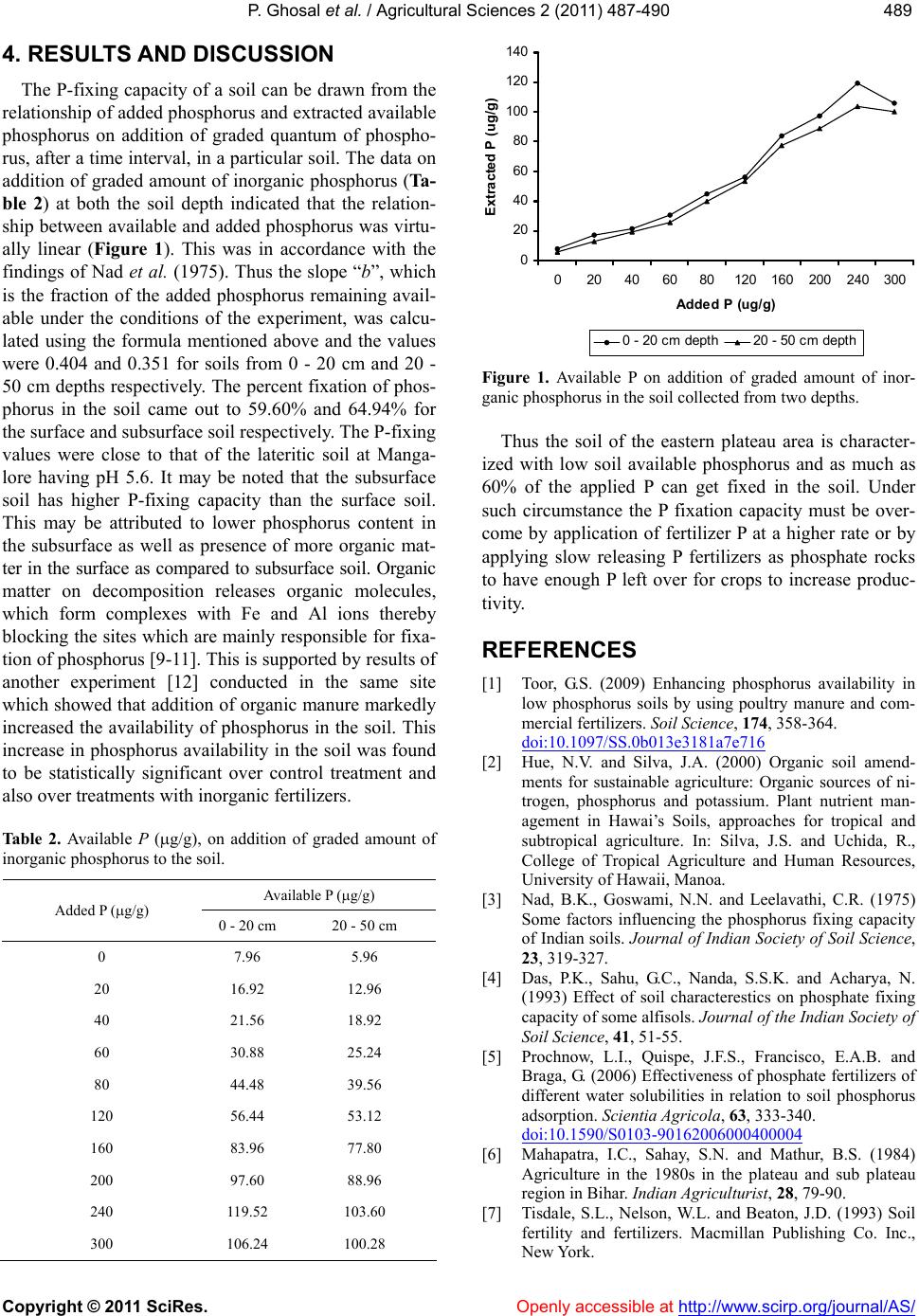
P. Ghosal et al. / Agricultural Sciences 2 (2011) 487-490
Copyright © 2011 SciRes. Openly accessible at http://www.scirp.org/journal/AS/
489489
4. RESULTS AND DIS CUSSION
The P-fixing capacity of a soil can be drawn from the
relationship of added phosphorus and extracted available
phosphorus on addition of graded quantum of phospho-
rus, after a time interval, in a particular soil. The data on
addition of graded amount of inorganic phosphorus (Ta-
ble 2) at both the soil depth indicated that the relation-
ship between available and added phosphorus was virtu-
ally linear (Figure 1). This was in accordance with the
findings of Nad et al. (1975). Thus the slope “b”, w hich
is the fraction of the added phosphorus remaining avail-
able under the conditions of the experiment, was calcu-
lated using the formula mentioned above and the values
were 0.404 and 0.351 for soils from 0 - 20 cm and 20 -
50 cm depths respectively. The percent fixation of phos-
phorus in the soil came out to 59.60% and 64.94% for
the surface and subsurface soil respectively. The P-fixing
values were close to that of the lateritic soil at Manga-
lore having pH 5.6. It may be noted that the subsurface
soil has higher P-fixing capacity than the surface soil.
This may be attributed to lower phosphorus content in
the subsurface as well as presence of more organic mat-
ter in the surface as co mpared to subsurface soil. Organic
matter on decomposition releases organic molecules,
which form complexes with Fe and Al ions thereby
blocking the sites which are mainly responsible for fixa-
tion of phosphorus [9-11]. This is supported by results of
another experiment [12] conducted in the same site
which showed that ad dition of organic manure markedly
increased the availability of phosphorus in the soil. This
increase in phosphorus availab ility in the soil was found
to be statistically significant over control treatment and
also over treatments with inorganic fertilizers.
Ta b le 2. Available P (g/g), on addition of graded amount of
inorganic phosphorus to the soil.
Available P (g/g)
Added P (g/g) 0 - 20 cm 20 - 50 cm
0 7.96 5.96
20 16.92 12.96
40 21.56 18.92
60 30.88 25.24
80 44.48 39.56
120 56.44 53.12
160 83.96 77.80
200 97.60 88.96
240 119.52 103.60
300 106.24 100.28
0
20
40
60
80
100
120
140
020 40 6080120160200240300
Added P (ug/g)
Extracted P (ug/g)
0 - 20 c m dept h20 - 50 c m dept h
Figure 1. Available P on addition of graded amount of inor-
ganic phosphorus in the soil collected from two depths.
Thus the soil of the eastern plateau area is character-
ized with low soil available phosphorus and as much as
60% of the applied P can get fixed in the soil. Under
such circumstance the P fixation capacity must be over-
come by application of fertilizer P at a higher rate or by
applying slow releasing P fertilizers as phosphate rocks
to have enough P left over for crops to increase produc-
tivity.
REFERENCES
[1] Toor, G.S. (2009) Enhancing phosphorus availability in
low phosphorus soils by using poultry manure and com-
mercial fertilizers. Soil Science, 174, 358-364.
doi:10.1097/SS.0b013e3181a7e716
[2] Hue, N.V. and Silva, J.A. (2000) Organic soil amend-
ments for sustainable agriculture: Organic sources of ni-
trogen, phosphorus and potassium. Plant nutrient man-
agement in Hawai’s Soils, approaches for tropical and
subtropical agriculture. In: Silva, J.S. and Uchida, R.,
College of Tropical Agriculture and Human Resources,
University of Hawaii, Manoa.
[3] Nad, B.K., Goswami, N.N. and Leelavathi, C.R. (1975)
Some factors influencing the phosphorus fixing capacity
of Indian soils. Journal of Indian Society of Soil Science,
23, 319-327.
[4] Das, P.K., Sahu, G.C., Nanda, S.S.K. and Acharya, N.
(1993) Effect of soil characterestics on phosphate fixing
capacity of some alfisols. Journal of the Indian Society of
Soil Science, 41, 51-55.
[5] Prochnow, L.I., Quispe, J.F.S., Francisco, E.A.B. and
Braga, G. (2006) Effectiveness of phosphate fertilizers of
different water solubilities in relation to soil phosphorus
adsorption. Scie ntia Agr icola, 63, 333-340.
doi:10.1590/S0103-90162006000400004
[6] Mahapatra, I.C., Sahay, S.N. and Mathur, B.S. (1984)
Agriculture in the 1980s in the plateau and sub plateau
region in Bihar. Indian Agricultu rist, 28, 79-90.
[7] Tisdale, S.L., Nelson, W.L. and Beaton, J.D. (1993) Soil
fertility and fertilizers. Macmillan Publishing Co. Inc.,
New York.